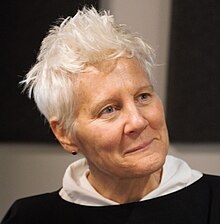
The Wexner Center for the Arts is the Ohio State University's "multidisciplinary, international laboratory for the exploration and advancement of contemporary art."
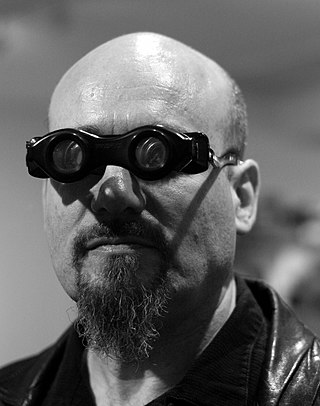
Perry Hoberman, is an installation artist who has worked extensively with machines and media. His career has included stints with Laurie Anderson and the USC Interactive Media Division.

Joan Jonas is an American visual artist and a pioneer of video and performance art, and one of the most important artists to emerge in the late 1960s and early 1970s. Jonas' projects and experiments were influential in the creation of video performance art as a medium. Her influences also extended to conceptual art, theatre, performance art and other visual media. She lives and works in New York and Nova Scotia, Canada.
Susan Weil is an American artist best known for her experimental three-dimensional paintings, which combine figurative illustration with explorations of movement and space.

Lorna Simpson is an American photographer and multimedia artist whose works have been exhibited both nationally and internationally. In 1990, she became the first African-American woman to exhibit at the Venice Biennale. She came to prominence in the 1980s and 1990s with photo-text installations such as Guarded Conditions and Square Deal that questioned the nature of identity, gender, race, history and representation. Simpson continues to explore these themes in relation to memory and history using photography, film, video, painting, drawing, audio, and sculpture.

Alyson Shotz is an American sculptor based in Brooklyn, New York. She is best known for experiential, large-scale abstract sculptures and installations inspired by nature and scientific concepts, which manipulate light, shadow, space and gravity in order to investigate and complicate perception. Writers suggest her work challenges tenets of monumental, minimalist sculpture—traditionally welded, solid, heavy and static—through its accumulation of common materials in constructions that are often flexible, translucent, reflective, seemingly weightless, and responsive to changing conditions and basic forces. Sculpture critic Lilly Wei wrote, "In Shotz’s realizations, the definition of sculpture becomes increasingly expansive—each project, often in series, testing another proposition, another possibility, another permutation, while ignoring conventional boundaries."

María Elena González is a Cuban-American sculptor based in Brooklyn and the Bay Area. She is known for objects, installations and public art that interweave post-minimalist form, conceptual art and concern for materials and craft. Her early work explored themes of memory, family, identity, loss and dislocation through formal, architectural and mapping modes that address site, place and social circumstances; her later work makes connections between nature and art, engaging a broad range of media and sensory experience. In 2020, artist and scholar Ellen Levy wrote "González's art re-invents nature as culture" through an "exquisite attunement" that uncovers formal and thematic analogies between both realms and synesthetic connections between visual and aural senses.
Paul Sietsema is a Los Angeles-based American artist who works primarily in film, painting and drawing. His work addresses the production, consumption, and proliferation of cultural objects, reflecting his interest in the possibility of an artwork to mediate information or meaning in a way that engages with the aesthetics of a specific time period. In the words of Sarah Robayo Sheridan, “Paul Sietsema compounds organic and artificial detritus in all his artwork, scavenging in history’s wake to identify specific tools of cultural production and foraging for concepts of art promulgated in the words of artists and attitudes of critics. He mines film as a vestige, the medium of the mechanical age, pressing and squeezing its very obsolescence through a contemporary sieve. In so doing, the artist hovers in the switchover between a bodily inscription in the image and a fundamental reconstitution of sight and representation in the matrix of the virtual. Where body stops and image starts is a divide collapsing through a series of innovations and accidents that go back as far as the people of Pompeii trapped in an emulsion that marked their death, but which paradoxically carried forward their image into eternity.”

Zoe Leonard is an American artist who works primarily with photography and sculpture. She has exhibited widely since the late 1980s and her work has been included in a number of seminal exhibitions including Documenta IX and Documenta XII, and the 1993, 1997 and 2014 Whitney biennials. She was awarded a Guggenheim Fellowship in 2020.
Barbara Bloom lives and works in New York City. She is a conceptual artist best known for her multi-media installation works. Bloom is loosely affiliated with a group of artists referred to as The Pictures Generation. For nearly twenty years she lived in Europe, first in Amsterdam then Berlin. Since 1992, she has lived in New York City with her husband, the writer-composer Chris Mann, and their daughter.
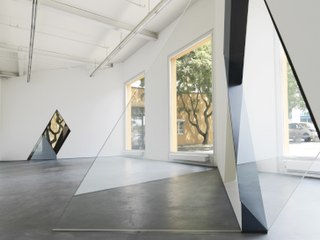
Sarah Oppenheimer is a New York City-based artist whose projects explore the articulations and experience of built space. Her work involves precise transformations of architecture that disrupt, subvert or shuffle visitors' visual and bodily experience. Artforum critic Jeffrey Kastner wrote that Oppenheimer's artworks "typically induce a certain kind of vaguely vertiginous, almost giddy uncertainty" that over time turns "indeterminacies of apprehension into epistemological uncertainties, epistemic puzzlement into ontological perplexity."
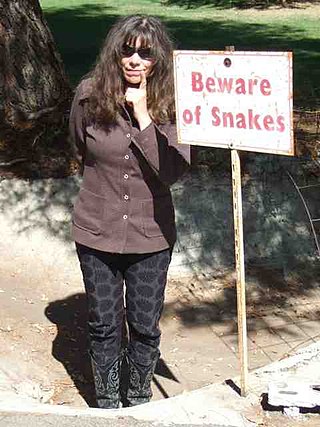
Mary Jo Bole, is a sculptor, printmaker, and artist-bookmaker who lives and works in Columbus, Ohio. Bole is a widely exhibited artist who has shown her works in the United States and Europe. She was a professor of art at The Ohio State University in Columbus, Ohio.

Annette Lemieux is an American artist who emerged in the early 1980s along with the "picture theory" artists. Lemieux brought to the studio a discipline equally based on introspection, and the manifestations of an ideological minimalism. Process is a key component in the execution of her works over the past three decades, creating the lure to the confrontation of issues of social and historical urgency. Lemieux has been the recipient of awards from the National Endowment of the Arts and the Keiser Wilhelm Museum, Germany and an honorary Doctorate in Fine Arts from Monserrat College of Art. Presently, in addition to her studio and exhibition schedule, she is a senior lecturer at Harvard University in the area of visual and environmental studies.

Simone Leigh is an American artist from Chicago who works in New York City in the United States. She works in various media including sculpture, installations, video, performance, and social practice. Leigh has described her work as auto-ethnographic, and her interests include African art and vernacular objects, performance, and feminism. Her work is concerned with the marginalization of women of color and reframes their experience as central to society. Leigh has often said that her work is focused on “Black female subjectivity,” with an interest in complex interplays between various strands of history. She was named one of the 100 most influential people in the world by Time magazine in 2023.

Kathy Goodell is an American contemporary artist based in New York City. She works in sculptural objects, installation, drawing and photography. She is a professor of painting and drawing at the State University of New York at New Paltz.
Judith Barry is an American artist, writer, and educator best known for her installation and performance art and critical essays, but also known for her works in drawing and photography. She is a professor and the director of the MIT Program in Art, Culture and Technology at the Massachusetts Institute of Technology, Cambridge, MA. She has exhibited internationally and received a number of awards.
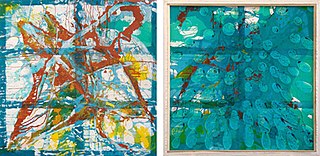
Dona Nelson is an American painter, best known for immersive, gestural, primarily abstract works employing unorthodox materials, processes and formats to disrupt conventional notions of painting and viewership. A 2014 New Yorker review observed, "Nelson gives notice that she will do anything, short of burning down her house to bully painting into freshly spluttering eloquence." Since 2002, long before it became a more common practice, Nelson has produced free-standing, double-sided paintings that create a more complex, conscious viewing experience. According to New York Times critic Roberta Smith, Nelson has dodged the burden of a "superficially consistent style," sustained by "an adventuresome emphasis on materials" and an athletic approach to process that builds on the work of Jackson Pollock. Writers in Art in America and Artforum credit her experimentation with influencing a younger generation of painters exploring unconventional techniques with renewed interest. Discussing one of Nelson's visceral, process-driven works, curator Klaus Kertess wrote, the paint-soaked "muslin is at once the tool, the medium, and the made."
Chie Fueki is a Japanese American painter. She has had an active career exhibiting her work in commercial galleries, and has been awarded a Guggenheim Foundation Fellowship. Fueki's intricate paintings combine influences from both Eastern and Western traditions. She currently lives and works in Beacon, New York.
Sigrid Sandström is a Swedish artist and a professor of Painting at the Academy of Fine Arts in Helsinki. Her work is characterized by graphic abstraction, an embrace of color and difference in scale, and an array of techniques used to apply paint and other materials to canvas, ranging from cloths and rugs, to masking with tape, squeegee-ing and smearing, and collaging. She has also worked in film and video, most notably for her 2005 exhibition Her Black Flags at the Mills College Art Museum in Oakland, CA, and in sculpture and installation. Artforum critic Naomi Fry, reviewing a 2007 show at Edward Thorp Gallery, cited the artist's interest in landscape as subject and noted that Sandström "also grapples here with painting’s essential difficulty in the face of the sublime. As the works consistently teeter on the verge of abstraction, the interplay between a more traditional naturalism and geometric fragmentation provides a salient tension."
Ann Pibal is an American painter who makes geometric compositions using acrylic paint on aluminum panel. The geometric intensity is one of the key characteristics that defines her paintings.

